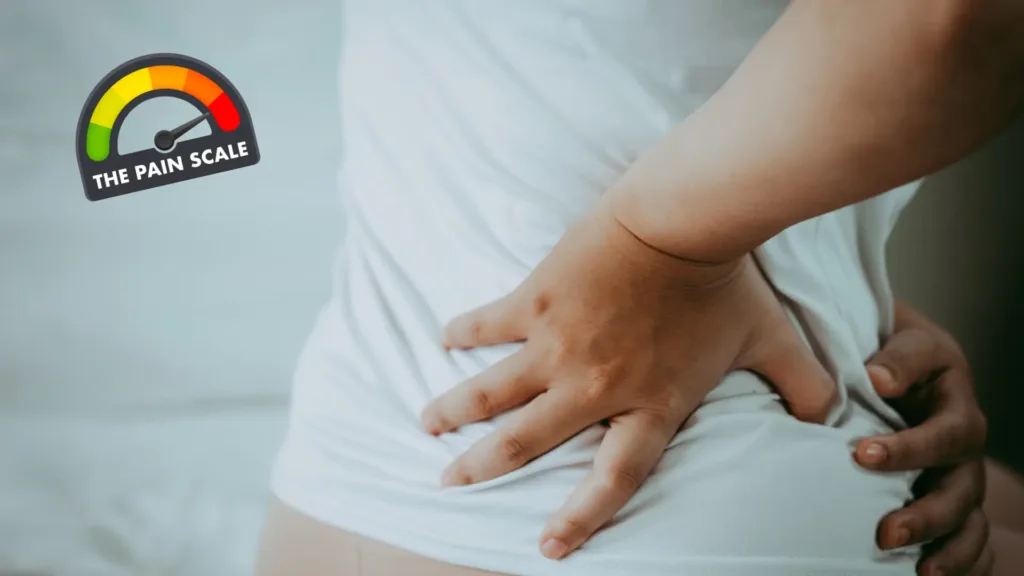You’re going about your day when suddenly, you feel a dull ache in your stomach—then your lower back starts hurting too. Coincidence? Maybe not.
Experiencing low back pain and stomach pain at the same time can be confusing, frustrating, and even scary. But here’s the deal—your body is trying to tell you something, and ignoring it could lead to serious consequences. Having both low back pain and stomach pain indicates a need for assessment.
So, let’s break it down. Why does this combo happen? And more importantly—what are the seven possible causes doctors want you to know about when you’re experiencing low back pain and stomach pain?
Table of Contents

Cause #1: Kidney Stones
What Are Kidney Stones?
Solid deposits of minerals and salts, called kidney stones, can accumulate within the kidneys.. Think of them as tiny razor-sharp rocks that cause intense pain as they travel through your urinary tract. That discomfort frequently manifests as both low back pain and stomach pain.
How They Trigger Pain in Both Areas
When the stone descends from your kidney towards the bladder, it’s capable of triggering:
- Stabbing low back pain (usually one-sided)
- Pain radiating toward the stomach or groin, contributing to overall low back pain and stomach pain
- Nausea or even vomiting
Symptoms to Watch For
- Sudden, sharp pain
- Bloody or cloudy urine
- Constant urge to pee, but in small amounts
- Fever or chills (if infected)
Cause #2: Urinary Tract Infection (UTI)
How a Simple Infection Can Spread
A UTI starts in the bladder, but if untreated, it can travel to your kidneys—and that’s when low back pain joins the party. This progression can lead to significant low back pain and abdomen pain.
Overlapping Pain in the Lower Abdomen and Back
- Burning sensation while urinating
- Cramping in the lower abdomen
- Dull or sharp back pain (especially near the sides), adding to your low back pain and stomach pain concerns.
Risk Factors and Signs
- More common in women
- Poor hygiene, dehydration, or catheter use
- Fever and strong-smelling urine are warning signs, especially with accompanying low back and abdomen pain.
Cause #3: Pancreatitis
A Deeper Internal Problem
This condition is an inflammation of the pancreas, usually triggered by gallstones, alcohol abuse, or high triglycerides. The ensuing inflammation can lead to both low back pain and stomach pain.
How It Feels in the Back and Stomach
The pain:
- Begins in the upper stomach
- It extends into the lower back, resulting in distinct low back pain.
- It might worsen after eating or drinking, making the low back pain and stomach pain feel more intense.
Lifestyle Links and Emergency Signs
- Alcoholism is a major risk
- Vomiting, fever, and a rapid pulse? Get to the ER—now. These are critical signs when experiencing low back pain and stomach pain.
Cause #4: Gastrointestinal Issues
Constipation, Gas, or Bloating
Trapped gas or constipation can build pressure in the abdomen and affect nerves that extend to the lower back. This common issue often presents as low back pain and stomach pain.
Symptoms may include:
- Sharp cramping
- Bloating and a full belly
- training can lead to an ache in your lower back, adding to discomfort in your abdomen.
Irritable Bowel Syndrome (IBS)
IBS can cause a mix of:
- Abdominal cramps
- Diarrhea or constipation
- Low back discomfort due to inflammation or posture issues, leading to persistent low back pain and stomach pain.
When Gut Trouble Radiates Backwards
Pay attention if your back pain comes after eating, during a bowel movement, or when bloated. This indicates a strong link between your digestive system and low back pain and stomach pain.
Cause #5: Gynecological Conditions (in Women)
Endometriosis and Ovarian Cysts
Conditions like endometriosis (when uterine tissue grows outside the uterus) or ovarian cysts can cause:
- Pelvic pressure
- Stomach pain
- Back pain that worsens during menstruation, leading to concurrent low back pain and stomach pain.
Period Pain That Affects the Lower Back
It’s common for cramps to extend to the lower back and thighs during a period. But when it’s severe or irregular, talk to a gynecologist, especially if you’re experiencing significant low back pain and stomach pain.
When to See a Gynecologist
- Pain during sex
- Irregular periods
- Ongoing pelvic pain outside menstruation, potentially indicating underlying causes for your low back pain and stomach pain.
Cause #6: Abdominal Aortic Aneurysm
The Silent and Serious Risk
In this condition, a bulge resembling a balloon develops in the wall of your abdominal aorta, the large blood vessel responsible for blood transport throughout your body.
Back + Belly Pain as a Warning
If it grows large or ruptures:
- Sudden, severe abdominal and low back pain
- Feeling faint or rapid heartbeat
- A pulsing feeling in the belly, all urgent signs of an emergent cause for low back pain and stomach pain.
Who Is at Risk?
- Smokers
- Males over 60
- Those with high blood pressure This is a medical emergency—call for help immediately if suspected, especially with the presentation of low back pain and stomach pain.
Cause #7: Muscle Strain or Spinal Issues
The Most Common Yet Overlooked Cause
Sometimes, it’s as simple as a strained muscle from lifting something wrong. But it can still cause:
- Low back pain
- Referred abdominal pain, contributing to the feeling of low back pain and stomach pain.
How Posture and Lifting Affect Both Areas
Poor posture or core weakness can make your back overcompensate, sending discomfort across your abdomen. This mechanical stress can directly result in low back pain and stomach pain.
When to Suspect It’s Muscular
- Pain worsens with movement
- No digestive or urinary symptoms
- Feels better with rest and heat therapy, distinguishing it from other causes of low back pain and stomach pain.
When Should You See a Doctor?
Red Flags You Should Never Ignore
If you’re experiencing low back pain and stomach pain along with any of these symptoms, seek immediate medical attention:
- Fever
- Vomiting
- Blood in urine or stool
- Pain lasting more than a few days
- Sudden, severe onset of pain
Home Remedies and First Aid
Tips for Short-Term Relief
When dealing with low back pain and stomach pain, these might offer temporary comfort:
- Apply a warm compress to both areas
- Try gentle stretches or light walking
- Stay hydrated
- Eat a bland diet if stomach is upset
What Not to Do
- Don’t ignore persistent or worsening symptoms of low back pain and stomach pain.
- Avoid self-medicating with painkillers long-term.
- Don’t apply heat if you suspect internal infection.
Prevention Tips
Healthy Habits That Can Help
To reduce your risk of low back pain and stomach pain:
- Drink enough water daily
- Don’t hold urine for too long
- Practice safe lifting and good posture
- Eat fiber-rich foods
- Avoid excess alcohol or fatty meals
Conclusion
Back and stomach pain together isn’t always serious, but it’s never something to brush off. From something as common as constipation to life-threatening conditions like an aneurysm, the cause matters—and your body is telling you to listen. Understanding the potential reasons behind low back pain and stomach pain is crucial.
Always observe the patterns, look for accompanying symptoms, and seek professional advice when needed for low back pain and stomach pain. In many cases, early diagnosis can make all the difference between a quick fix and a serious problem.
FAQ
1. Can gas or bloating cause low back pain and stomach pain together? Yes, trapped gas and bloating can create pressure in the abdomen, which can then radiate and cause discomfort or pain in the lower back. This is a very common reason for experiencing both low back pain and stomach pain.
2. What serious conditions can cause both low back pain and stomach pain? Serious conditions include kidney stones, pancreatitis, appendicitis, an abdominal aortic aneurysm, and in some cases, certain types of cancer. These conditions often present with both low back pain and stomach pain as key symptoms.
3. Is it normal for period pain to cause low back pain and stomach pain? Yes, menstrual cramps often cause referred pain that extends to the lower back and thighs, in addition to abdominal pain. Conditions like endometriosis or ovarian cysts can intensify this experience of low back pain and stomach pain during menstruation.
4. How can I tell if my low back pain is related to my kidneys or just muscle strain? Kidney pain is typically felt deeper, often on one side of the lower back, near the ribs, and may be accompanied by fever, nausea, vomiting, or changes in urination (e.g., blood in urine, frequent urge to pee). Muscle strain low back pain is usually worsened by movement and improves with rest and heat, without urinary or digestive symptoms.
5. When should I seek immediate medical attention for low back pain and stomach pain? Seek immediate care if you experience sudden, severe pain, fever, vomiting, blood in your urine or stool, numbness or weakness in your legs, or problems with bowel or bladder control alongside your low back pain and stomach pain.
6. Can IBS (Irritable Bowel Syndrome) cause both low back pain and stomach pain? Yes, IBS can cause abdominal cramps, bloating, and changes in bowel habits (diarrhea or constipation), which can, in turn, lead to discomfort and low back pain due to referred pain or altered posture.
7. What lifestyle factors contribute to experiencing low back pain and stomach pain? Poor diet (leading to constipation or gas), dehydration, lack of exercise, improper lifting techniques, poor posture, and even stress can all contribute to either low back pain, stomach pain, or both.
8. What tests might a doctor order to diagnose the cause of low back pain and stomach pain? Depending on your symptoms, a doctor might order blood tests, urinalysis, ultrasound, CT scans, MRI scans, or sometimes an endoscopy to determine the underlying cause of your low back pain and stomach pain.
9. Can chronic conditions like fibromyalgia lead to low back pain and stomach pain? Yes, chronic pain syndromes like fibromyalgia can manifest as widespread pain, including both low back pain and stomach pain, along with other symptoms like fatigue and tenderness.
10. What are some immediate home remedies for mild low back pain and stomach pain? For mild cases, applying a warm compress to both areas, trying gentle stretches, staying hydrated, and eating a bland diet if stomach upset is present can offer temporary relief from low back pain and stomach pain. However, persistent or worsening symptoms should always be evaluated by a doctor.
Related Reading
- The Ultimate Guide to Low Back Pain ICD-10 Codes (With Real-Life Examples!)
- 5 Warning Signs Your Hip Pain Is Actually a Back Issue
- Vertebrogenic Low Back Pain: The Hidden Culprit Behind Your Chronic Low Back Pain
With 20+ years of clinical experience in spine, joint, and pain management, Dr. Vivek ensures every article reflects accurate, trustworthy, and up-to-date health advice.
Learn more about Dr. Vivek’s qualifications & journey →

Dr. Vivek Arora (BPT, MPT, FRCPT, MIAP) is a licensed physiotherapist with over 20 years of experience in spine and joint care. He specializes in evidence-based physiotherapy, patient education, and long-term recovery without surgery. Passionate about empowering patients through knowledge, Dr. Arora shares expert-backed health content for a global audience.
To know more about Dr. Vivek’s journey, click here.
